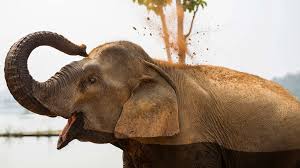In the realm of cultural symbols and artistic expressions, few icons captivate the imagination as profoundly as the golden painted elephant. Across centuries and continents, elephants have been revered as embodiments of wisdom, strength, and longevity. The allure of these majestic creatures is further magnified when adorned in gold, a hue that signifies wealth, divinity, and timeless beauty. The golden painted elephant is not merely an artistic representation; it is a confluence of nature’s grandeur and human creativity, a testament to the deep-seated reverence for these magnificent animals in various cultures. This article delves into the enchanting world of the golden painted elephant, exploring its historical significance, cultural symbolism, and the intricate artistry that brings this mesmerizing icon to life.
The Enchantment of the Golden Painted Elephant
The golden painted elephant has long been a symbol of opulence and sacredness in many cultures, especially in Asia and Africa. Elephants, by themselves, hold a place of high esteem in various societies, often associated with deities, royalty, and wisdom. When these majestic animals are rendered in gold, their symbolic value multiplies manifold, merging the regal stature of the elephant with the splendor of gold. This combination is not only visually stunning but also culturally significant, representing a blend of nature’s power and human reverence.
In India, for instance, elephants are integral to religious and cultural narratives. The Hindu deity Ganesha, who has the head of an elephant, is worshipped as the remover of obstacles and the god of beginnings. During festivals like Diwali and Ganesh Chaturthi, golden images and statues of Ganesha are prominently displayed and revered. Similarly, in Buddhist traditions, the white elephant is a symbol of purity and knowledge, and golden depictions of elephants can often be found in temples and religious artworks.
The allure of the golden painted elephant also extends to Africa, where elephants are considered symbols of strength, power, and familial bonds. In many African cultures, elephants are seen as wise leaders of the animal kingdom, and their golden representations are cherished as symbols of prosperity and protection. These golden depictions are not only artistic expressions but also convey deep cultural narratives about respect for nature and the importance of community and leadership.
The Artistry of the Golden Painted Elephant
Creating a golden painted elephant is a meticulous process that combines traditional craftsmanship with artistic innovation. The process often begins with a detailed sketch or model of the elephant, capturing its majestic form and intricate details. This model serves as the foundation upon which layers of gold paint or gold leaf are applied. The application of gold is a delicate process, requiring precision and skill to ensure that the gold adheres properly and highlights the elephant’s features in the most striking way.
Artists often incorporate other decorative elements into the golden painted elephant, such as precious stones, intricate patterns, and symbolic motifs. These additions not only enhance the visual appeal of the artwork but also imbue it with additional layers of meaning. For instance, patterns and symbols might represent various aspects of the elephant’s cultural significance, from its role as a divine messenger to its status as a symbol of earthly power.
The use of gold itself is laden with symbolism. Gold has been associated with the divine and the eternal in many cultures, representing not just wealth but also purity and enlightenment. When applied to the image of an elephant, gold elevates the creature to a higher plane of symbolic significance, transforming it from a mere representation of an animal to a revered icon of spiritual and cultural values.
The Golden Painted Elephant in Modern Culture
The fascination with the golden painted elephant continues in modern times, transcending its traditional cultural boundaries and finding new expressions in contemporary art and design. Today, golden painted elephants are not only found in temples and cultural artifacts but also in fashion, home decor, and even modern art installations. This enduring appeal speaks to the timeless allure of the golden painted elephant, as it continues to capture the imagination of people around the world.
In the realm of home decor, golden painted elephants are often used as statement pieces that add a touch of exotic elegance to interior spaces. These decorative items can range from small figurines to large statues, each one a testament to the craftsmanship and artistic vision that goes into their creation. The presence of a golden painted elephant in a home is more than just an aesthetic choice; it is a symbol of good fortune, prosperity, and a deep appreciation for cultural heritage.
Contemporary artists have also embraced the golden painted elephant as a subject of creative exploration. Through various mediums, from painting and sculpture to digital art, artists reimagine the golden painted elephant in ways that resonate with modern sensibilities while paying homage to its rich cultural roots. These modern interpretations often blend traditional techniques with innovative approaches, resulting in artworks that are both timeless and contemporary.
Conclusion
The golden painted elephant remains an enduring symbol of cultural richness and artistic excellence. Its timeless allure lies in the harmonious blend of nature’s majesty and human ingenuity, creating an icon that transcends cultural and temporal boundaries. Whether revered in religious contexts, celebrated in cultural festivities, or admired as a work of art, the golden painted elephant continues to captivate and inspire.
As we look to the future, the golden painted elephant will undoubtedly maintain its place as a cherished symbol of wisdom, strength, and beauty. Its presence in modern culture serves as a reminder of our enduring connection to the natural world and our ability to create art that resonates with timeless values. The golden painted elephant is more than just an artistic representation; it is a symbol of the human spirit’s capacity to find beauty and meaning in the world around us. Through the ages, this majestic icon will continue to shine, reflecting the enduring allure of both the elephant and the artistry that brings it to life.




